A short while ago, a thread on the forums discussed whips and the fact that few anglers seemed to use them these days.
That is a great pity indeed, but then the whole pattern of general coarse fishing has changed these past fifteen years, ever since the ending of the close season on lakes and/also (perhaps because of) the growth in commercial ponds where small fish are not longer the targets, more small to medium carp now.
I think it was 1995 when it was announced that the close season would no longer be applied to lakes and fully enclosed waters (followed two years later by canals). Many believe that it was pressure from commercial fisheries that caused this change as so many were getting around the close season rules by stocking trout and allowing any method fishing. Of course, anglers flocked to these sites and bagged up, but not on trout, unless purely accidental, it was on young carp.
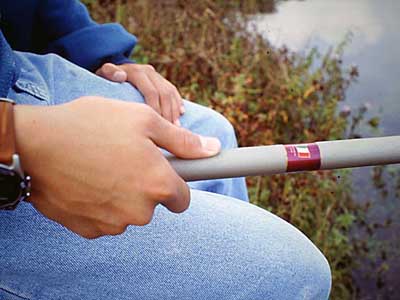 |
| Whips should be held in one hand. |
Since then the growth in commercial fisheries has been phenomenal and the average carp in them has also grown from what may have been an average of a few pounds to now over twenty pounders. Hence the move in recent years from fishing 6s or 8s elastics in a pole to 20+s elastics or whatever the equivalent hollow number/colour is. As implied by one manufacturer when he said, to the effect, “Who’s interested these days in catching 300 gudgeon or bleak from the Shropshire Union Canal when you can bag up on a commercial?” He’s right, but such a pity.
Well, for me there are those days when both types of fishing will set their own challenge. Nice to catch a net full of carp now and then, but also nice to take a break and catch the 300 gudgeon. Both require different skills and variety is the spice of life as far as I’m concerned.
Discovering what whips were…
I remember the day that I first used a whip and became converted. I’d been fishing a small lake and I got a shoal of perch sitting in about 8 feet of water some 5 meters from the bank. I could reach them with my rod and a short cast, but the effort of keep winding in a little to land the fish, re-baiting and casting again became a real chore, how I wished I could do this without the reel.

My Maver Alborella tele/take apart whip. The yellow nose cone is where the 4th section fits into the telescopic top section.
Someone loaned me a Maver Alborella 6 metre tele/take-apart whip and that was it. Next visit to the same swim it was a dream. I could use the whip at just 5 metres by not using the butt section and still had enough line on the drop to cover the depth of water and a fair drop to the float from rod tip. The next week I bought the very same whip, I think from Leslies of Luton and they were even gracious enough to stick a Stonfo connector on the fine carbon tip for me.
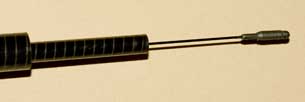 |
| The Stonfo in closed position |
Lots of occasions followed where I could use that whip, sure it was great fun catching perch, which it handled with alacrity, but on the bigger lake I could snatch out loads of bleak including some monsters, I bet they were nudging four ounces. Yes, that is BIG for a bleak, but I did once catch one of over 5 ounces. It was difficult to weigh with any degree of accuracy on 42lbs scales and since we didn’t want the fish to suffer, it was returned unharmed. I even won a match once with a catch of almost all bleak with the odd roach and perch. I have to say that it helped that the club captain, a cracking unbeatable matchman, had fallen from a tree ripping his tendon and couldn’t fish that weekend.
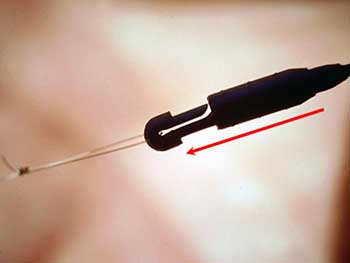 |
|
Stonfo open with line loop inserted. |
I even fished one little ditch where the water was about 2 feet deep, but in the bottom of a 10 feet deep furrow. The captured rudd were then transferred from that section, which was prone to drying out, to a deeper and more accessible section further down. Since I had to split the whip, the telescopic from the put over sections, at each catch and I fitted a nose cone to make the job of rejoining easier and save the edge of the female joint. The nose cone has remained fitted.
Some little time later, I was taking this young lad out fishing, Omar was his name. He was 13 at the time and quite keen on catching and also learning how to catch and how to care for fish. I then set him a task, to catch 100 fish, rudd and tench, from a small lake in – 3 hours!
The challenge worried him, but we first of all got him a whip, it was a Browning 4 metre carbon job and very nice too. First job was to show him the disciplines of using the whip, how to sit, how to hold it for fishing, how to hold it for resting when fishing wasn’t a furious. All this he took in his stride and off we went to Odney to practice on Lille Brook, for those of you who know this.
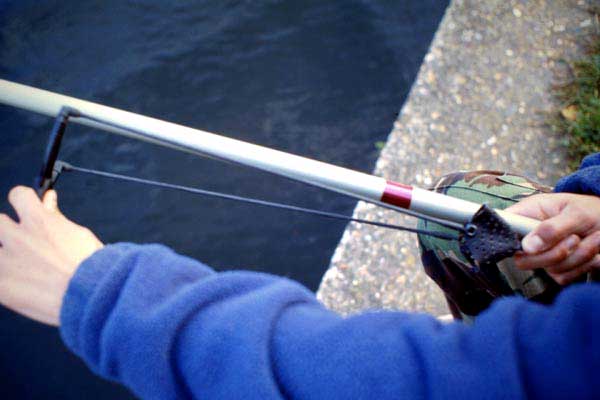
Using a catapult to fire loose feed whilst holding the whip still
Here he started catching dace and roach, only small, perhaps the biggest being around 6 ounces. In two hours he’d had perhaps 40 fish, which on a wild stream running fast wasn’t too bad at all. We then moved onto the Thames, the free stretch at Marlow, which was then quite heavily populated with anglers in the summer and we had to squeeze in on a bit of high bank, not the ideal.
However, his luck continued and he struck into dace after dace for a further two hours drawing admiring glances from the other anglers on there, some of whom struggled. I think after his 4 or so hours of fishing he’d had more than 80 fish so why it worried him to be challenged to catch 100 from a tame lake where I knew they’d be climbing up his whip to meet him, I can’t imagine. Before we could go to said lake, we were beset with some heavy weather, so it was a few weeks before we made it.
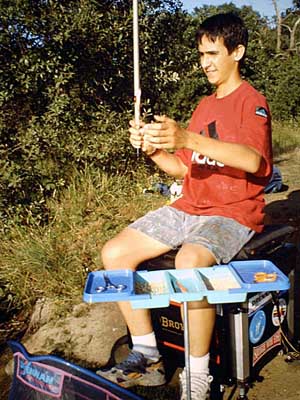 The whip fishing challenge…
The whip fishing challenge…
The day arrived when everything looked perfect, light breeze, a bit of currant bun (sun), fairly warm water, just right for catching loads of rudd and small tench. I had a pad to record his fish count and timed him on the watch, I didn’t fish, just looked after him although he unhooked the fish, changed and fed the bait, and even had spare hooklinks etc. standing by.
Off he set, offering a bit of groundbait feed to get them concentrated, and in no more than seconds had the first fish on. This continued and I felt like a spare, having nothing to do but group the fish count – IIIII IIIII IIIII etc. One hour on and he was well over half way to his target of 100 fish. After two hours he’d well and truly beaten the target and he settled back into a steadier pattern of catching now.
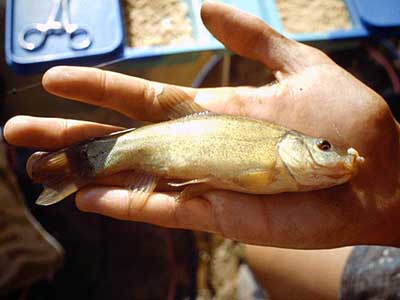
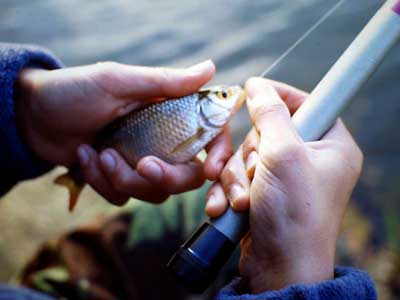
Tench and rudd came in all the time.
After three hours we stopped. I totalled up the strokes in my pad and counted (did I miss one or two here and there?) 187 fish. Why was he worried?
To be honest, you can feel like you’re a catching machine when it goes well on the whip, the continentals can take up to 6 fish per minute or the right waters in the right conditions and whip fishing over there is still very popular. I’ve even checked with Maver to see if anything like the old Alborella 6mtr is still available and no, not in this country, but the PDF catalogue they sent to me is full of all manner of poles and whips. The difficulty I had was translating from French, a bit out of practice I’m afraid.
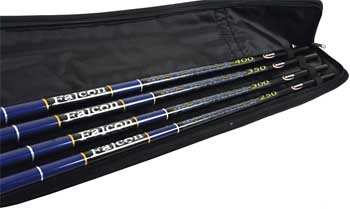 |
| Maver’s Falcon Alborella set |
Maver still do a set of whips called the Falcon Alborella, but it’s four separate whips (ideal for matchmen) from 2.5 mtrs to 4 mtrs and comes at a price, £190. A pity because the old Alborella 6mtr could be fished like most of these, but up to 6 metres and the cost (from memory) was around £130. OK, main disadvantage, you could only fish it at one length at a time and would need to change your rig line if you wanted it longer or shorter, but for most anglers this would have suited.
It’s just a pity that fishing, or rather the attitude to fishing, has changed so much in the last 15 years. Whips still can provide that ‘fun’ element to the sport and cheap ones at 4 metres are still very much available and are a great way to start youngsters off. Let’s face it, there’s nothing to worry about but a rod and a line – no reel, no complications.
Just a funny though to finish on. Another friend of mine fished with me one day and saw the whip I was using, he got himself a 5 metre whip by Colmic. We went up on the Thames one day and he was having a great time with roach and dace until he hooked into something that felt a bit more solid. On lifting it to the surface he saw it was a pike of around 5 lbs that had probably made a grab for a small fish he might have had on.
We could see the pike was hooked firmly in the scissors and wasn’t going to chew through the line so easily. The whip was bent over double almost and so afraid of it breaking, he just followed the fish off downstream. After 50 yards I shouted “I’d best phone the Port of London Authority and tell them to expect you in a couple of days time!” It didn’t last that long and we netted it some ten minutes later, the whip was fine.
Good things whips!










